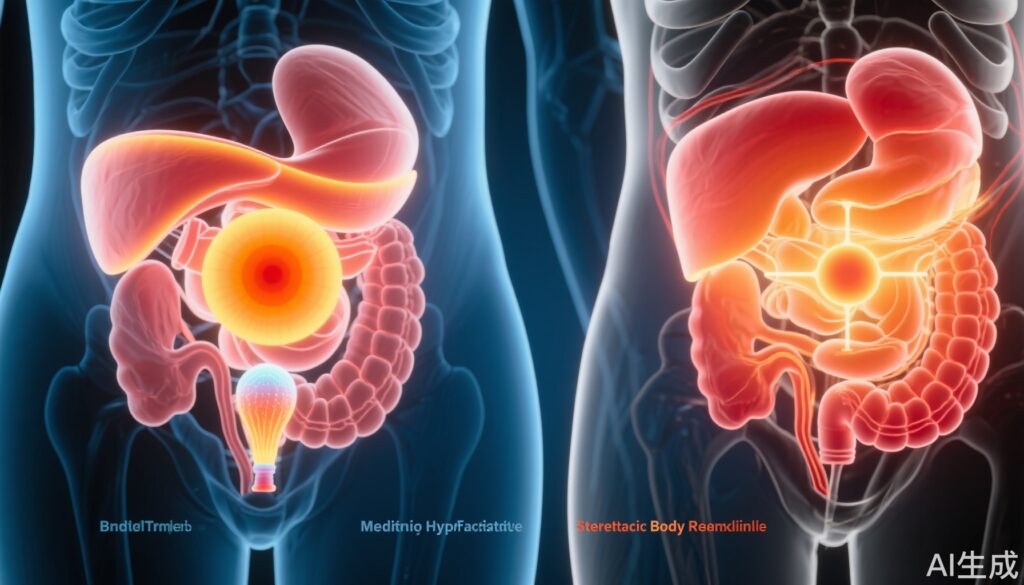Highlight
- The PACE-C trial compared early toxicity of MHRT versus SBRT in intermediate- and high-risk prostate cancer patients receiving androgen deprivation therapy.
- No significant difference in early Radiation Therapy Oncology Group (RTOG) grade 2 or worse genitourinary or gastrointestinal toxicity was observed between MHRT and SBRT.
- SBRT, despite a shorter treatment schedule and larger treated volume than in prior low-risk studies, showed a similar safety profile to MHRT.
- These results support SBRT as a potential alternative to MHRT in higher-risk prostate cancer pending long-term efficacy data.
Study Background and Disease Burden
Prostate cancer remains a leading cause of cancer morbidity among men worldwide, with treatment strategies tailored according to risk stratification. Moderately hypofractionated radiotherapy (MHRT) has become a standard treatment, offering comparable efficacy and toxicity to conventional fractionation with fewer treatment visits. Stereotactic body radiotherapy (SBRT) delivers higher doses per fraction over fewer sessions and has demonstrated non-inferiority to MHRT in low-risk prostate cancer patients without the need for hormone therapy, as shown in the PACE-B trial. However, for intermediate- and high-risk prostate cancer patients—who often receive androgen deprivation therapy and require treatment of a larger target volume—randomised data on SBRT toxicity remain limited. This gap presents a critical clinical question regarding the safety and tolerability of SBRT in these higher-risk groups.
Study Design
The PACE-C trial is a multicentre, randomised, open-label, phase 3, non-inferiority study conducted in 53 hospitals across the UK, Republic of Ireland, and New Zealand. It enrolled men aged 18 years or older with histologically confirmed intermediate- or high-risk prostate adenocarcinoma (T1-T3a, Gleason scores 7-8, PSA 10-30 ng/mL) and WHO performance status 0–2. Participants were randomly assigned 1:1 to receive either MHRT (60 Gy delivered in 20 daily fractions over 4 weeks) or SBRT (36.25 Gy delivered in five fractions over 1–2 weeks), with an additional mandatory clinical target volume dose of 40 Gy to the prostate and proximal 1 cm of seminal vesicles without margins. Six months of androgen deprivation therapy was administered before radiotherapy in all patients. The primary outcome of the overall trial is freedom from biochemical or clinical failure, with results pending. This article reports on a preplanned safety analysis focusing on early toxicity.
Key Findings
Between November 2019 and June 2022, 1208 patients were randomised (601 MHRT, 607 SBRT), with 1192 receiving treatment (608 MHRT, 584 SBRT). The cohort was predominantly White (95%), with smaller proportions of Black, Asian, and other ethnic groups.
The co-primary endpoints assessed were the proportions of patients experiencing Radiation Therapy Oncology Group (RTOG) grade 2 or worse genitourinary and gastrointestinal toxicities during or within 12 weeks after radiotherapy.
– Genitourinary Toxicity: RTOG grade ≥2 genitourinary toxicity occurred in 27% of MHRT patients and 28% of SBRT patients (absolute difference 0.5%, 95% CI -4.7 to 5.7; p=0.89), indicating no statistically significant difference. Using Common Terminology Criteria for Adverse Events (CTCAE), grade ≥2 genitourinary toxicity was 28% after MHRT and 34% after SBRT (p=0.050). Grade 3 genitourinary toxicity was rare (<1%) and similar between groups.
– Gastrointestinal Toxicity: RTOG grade ≥2 gastrointestinal toxicity was observed in 11% of MHRT and 13% of SBRT patients (absolute difference 1.4%, 95% CI -2.5 to 5.2; p=0.53). CTCAE grade ≥2 gastrointestinal toxicity was higher in the SBRT group (17%) than MHRT (10%), reaching statistical significance (p=0.0011), though grade 3 events remained rare (<1%).
No treatment-related deaths occurred.
These results demonstrate that despite the accelerated and more condensed treatment schedule of SBRT and the inclusion of a larger target volume than in previous lower-risk studies, early genitourinary and gastrointestinal toxicities are comparable to MHRT.
Expert Commentary
The PACE-C trial provides valuable randomized evidence addressing the safety of SBRT in a higher-risk prostate cancer population receiving androgen deprivation therapy. The similarity in early RTOG toxicity between SBRT and MHRT supports the expanding use of SBRT in this group, potentially offering logistical advantages with fewer treatment visits. The modest increase in CTCAE grade ≥2 gastrointestinal toxicity with SBRT warrants continued monitoring, especially as late toxicity data mature.
Limitations include the relatively short follow-up for toxicity and efficacy, and the predominance of White patients, which may affect generalizability. Ongoing follow-up will clarify long-term outcomes and biochemical control. These findings align with evolving international guidelines that increasingly recognize SBRT as a viable option for intermediate-risk disease, contingent on robust toxicity monitoring.
Conclusion
The PACE-C trial’s early toxicity results indicate that stereotactic body radiotherapy is not inferior to moderately hypofractionated radiotherapy in terms of early genitourinary and gastrointestinal toxicity in intermediate- and high-risk prostate cancer patients undergoing androgen deprivation therapy. This supports SBRT as a safe and convenient alternative with a shortened treatment duration. Further maturation of efficacy and late toxicity data is essential to establish its definitive role in high-risk prostate cancer management.
References
Tree AC, Hinder V, Chan A, et al; PACE Investigators. Intensity-modulated moderately hypofractionated radiotherapy versus stereotactic body radiotherapy for prostate cancer (PACE-C): early toxicity results from a randomised, open-label, phase 3, non-inferiority trial. Lancet Oncol. 2025 Jul;26(7):936-947. doi:10.1016/S1470-2045(25)00205-0. Epub 2025 Jun 12. PMID: 40517778; PMCID: PMC7617972.
National Comprehensive Cancer Network. Prostate Cancer (Version 4.2024). NCCN Clinical Practice Guidelines in Oncology. Available at: https://www.nccn.org
Morgan SC, Hoffman K, Loblaw DA, et al. Hypofractionated Radiation Therapy for Localized Prostate Cancer: Executive Summary of an ASTRO, ASCO, and AUA Evidence-Based Guideline. Pract Radiat Oncol. 2018;8(6):354-360. doi:10.1016/j.prro.2018.06.002



